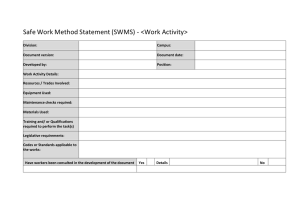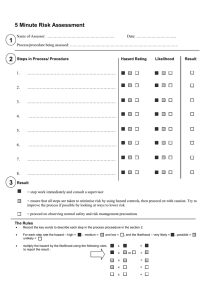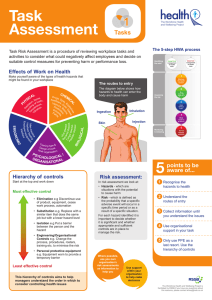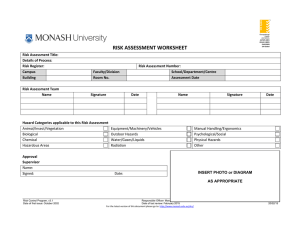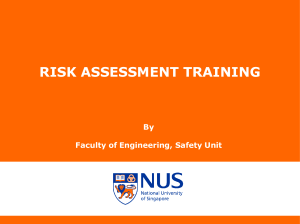Risk Assessment
advertisement
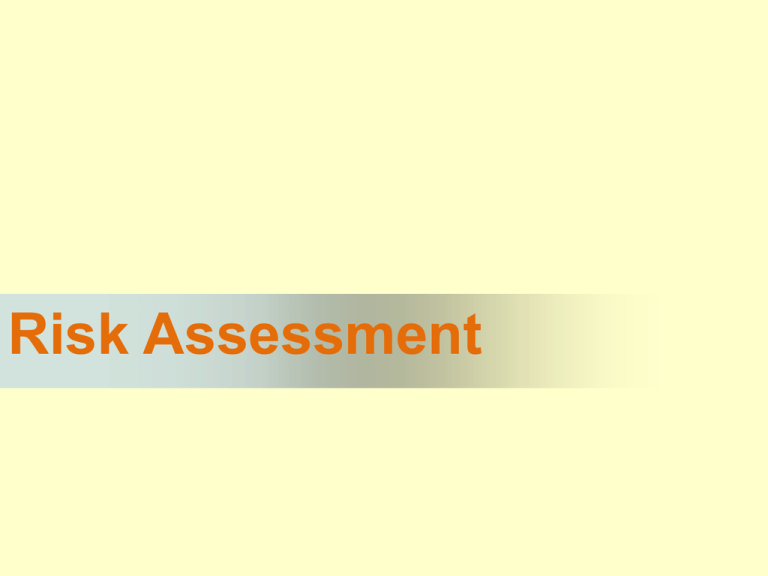
Risk Assessment Learning outcomes 1. Explain the aims and objectives of risk assessment 2. Identify hazards by means of workplace inspection and analysis of tasks 3. Explain the principles and practice of risk assessment. What is Risk Assessment? Risk Assessment is a systematic approach to identify hazards, evaluate risk and incorporate appropriate measures to manage and mitigate risk for any work process or activity. The objectives of risk assessment: Why we need to do risk assessment? Protect Ourselves RA is key to prevention of accident Everyone deserve to go home safely at the end of the day Elevate safety awareness & ownership Aware of hazards, risks and controls and practicing safe science University and Faculty Procedures Compliance with Regulations Health risks Risk assessment is not only concerned with injuries in the workplace but also needs to consider the possibility of occupational ill health. Health risks fall into the following four categories: Chemical (paint solvents, exhaust fumes) Biological (bacteria, pathogens) Physical (e.g. noise, vibrations) Psychological (e.g. occupational stress). Health risks There are two possible health effects of occupational ill health. They may be acute , which means that they occur soon after the exposure and are often of short duration, although in some cases emergency admission to hospital may be required. They may be chronic , which means that the health effects develop with time. It may take several years for the associated disease to develop and the effects may be slight (mild asthma) or severe (cancer). The management of risk assessment Hazard identification Hazard identification is the crucial first step of risk assessment. Only significant hazards, which could result in serious harm to people, should be identified. Trivial hazards should be ignored. A tour of the area under consideration by the risk assessment team is an essential part of hazard identification as is consultation with the relevant section of the workforce. A review of accident, incident and ill-health records will also help with the identification. It is important that unsafe conditions are not confused with hazards, during hazard identification. Persons at risk Employees and contractors who work full time are the most obvious groups at risk and it will be a necessary check that they are competent to perform their particular tasks. Members of the public will include visitors, patients, students or customers as well as passers-by. The risk assessment must include any additional controls required due to the vulnerability of any of these groups, perhaps caused by inexperience or disability. It must also give an indication of the numbers of people from the different groups who come into contact with the hazard and the frequency of these contacts. Evaluation of risk level Qualitative risk analysis During the risk assessment, a judgment is made as to whether the risk level is high, medium or low. This designation defines a timetable for remedial actions to be taken thereby reducing the risk. High-risk activities should normally be addressed in days, medium risks in weeks and low risks in months or in some cases no action will be required. It will usually be necessary for risk assessors to receive some training in risk level designation. Quantitative risk analysis A quantitative risk assessment attempts to quantify the risk level in terms of the likelihood of an incident and its subsequent severity. Clearly the higher the likelihood and severity, the higher the risk will be. The likelihood depends on such factors as the control measures in place, the frequency of exposure to the hazard and the category of person exposed to the hazard. The severity will depend on the magnitude of the hazard (voltage, toxicity, etc.). HSE suggests in HSG65 a simple 3 x 3 matrix to determine risk levels. Evaluation of risk level Likelihood of occurrence level Harm is certain or near certain to occur Harm will often occur Harm will seldom occur Severity of harm Death or major injury (as defined by RIDDOR) 3-day injury or illness (as defined by RIDDOR) All other injuries or illnesses Risk = Severity x Likelihood Likelihood High 3 Medium 2 Low 1 Severity level Major 3 Serious 2 Slight 1 Thus: 6–9 High risk 3–4 Medium risk 1–2 Low risk RISK CONTROL What can be done to control risks in the workplace ? Some measures are : ( from most to least preferred ) Elimination – eliminate the hazard from the workplace Substitution - substituting a hazardous substance or process with a less hazardous one. Engineering controls - installing machine guarding or enclosing a noisy machine. Administrative controls - applying a permit-towork system or lock-out and tag-out procedures. PPE - provision and use of these equipment, AND SWP – Safe Work Procedures Hierarchy of Risk Control Measures Additional Controls Additional control for risk rated more than 3 or medium & high risk Reduce risk to as low as reasonably practicable Who and When? Responsible person to implement the identified control measures and Timeline for completion update the risk assessment upon completion of the additional control measures
